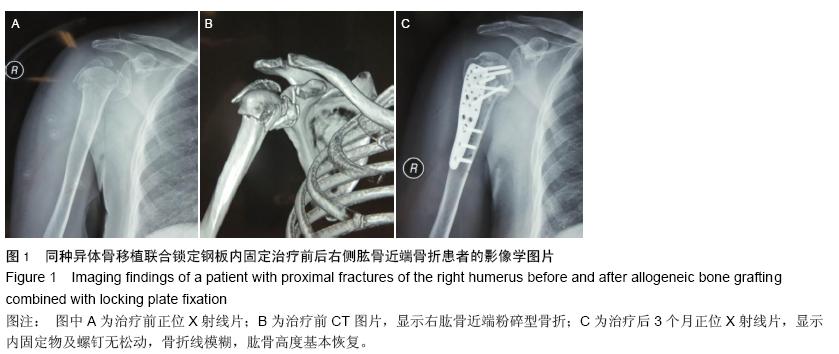| [1] 王众,李强,范顺武.肱骨近端锁定钢板结合同种异体骨移植治疗老年肱骨外科颈骨折的疗效[J].中国老年学杂志, 2012,32(9):1798-1799.[2] Hettrich CM,Neviaser A,Beamer BS,et al.Locked plating of the proximal humerus using an endosteal implant.J Orthop Trauma.2012;26(4):212-215. [3] 陈孝均,陈红生,邹永根,等.同种异体腓骨移植锁定钢板固定治疗C2 型肱骨近端骨折[J]. 中国修复重建外科杂志, 2014,28(2):202.[4] Euler SA,Hengg C,Wambacher M,et al.Allogenic bone grafting for augmentation in two-part proximal humeral fracture fixation in a high-risk patient population.Arch Orthop Trauma Surg.2015;135(1):79-87.[5] Gross RH.The use of bone grafts and bone graft substitutes in pediatric orthopaedics: an overview.J Pediatr Orthop.2012;32(1):100-105.[6] 赵丹,李同林,马勇,等.同种异体骨移植的研究进展[J].安徽医科大学学报,2013,48(5): 577-580.[7] 曾浪清,陈云丰,王磊,等.锁定钢板治疗Neer三部分及四部分肱骨近端骨折疗效[J].中国修复重建外科杂志,2012, 26(12):1469-1472.[8] Iannotti JP,Williams GR.Disorders of the shoulder: diagnosis and mangement. Philadelphia: Lippinccott Williams & Wilkins,1999:1015-1016. [9] 江红卫,曹烈虎,宋绍军,等.纳米人工骨与同种异体骨植骨治疗肱骨近端Ⅲ、Ⅳ型骨折的临床疗效对比[J].上海医学, 2012,35(11):954-956.[10] 陈志林,袁太珍,龚国龄,等.应用肱骨近端锁定钢板治疗肱骨近端骨折[J].中国骨与关节损伤杂志, 2014,29(3): 243-245.[11] 李毅.有限切开锁定加压钢板内固定加异体植骨对复杂性肱骨干骨折的临床疗效[J].中外医疗,2014,33(13): 99+101.[12] 曾浪清,陈云丰.肱骨近端骨折内固定失败危险因素的研究进展[J].中华创伤骨科杂志, 2012,14(4):346-349.[13] 柳辑章.肱骨骨折锁定钢板内固定术后失败原因分析[J].职业卫生与病伤,2014,29(2): 123-124.[14] 杜丽河.肱骨近端锁定接骨板结合异体骨植骨治疗外翻嵌插型四部分肱骨近端骨折[J].医学理论与实践,2014, 27(22):3014-3015.[15] 饶海群,黄大江,吴渊,等.肱骨近端骨折保守治疗后并发症的探讨[J].中国矫形外科杂志,2014,22(22): 2049-2052.[16] Gardner MJ,Boraiah S,Helfet DL,et al.Indirect medial reduction and strut support of proximal humerus fractures using an endosteal implant.J Orthop Trauma. 2008;22(3):195-200.[17] Lee CW,Shin SJ.Prognostic factors for unstable proximal humeral fractures treated with locking-plate fixation.JSES.2009;18(1):83-88.[18] Neviaser AS,Hettrich CM,Beamer BS,et al.Endosteal strut augment reduces complications associated with proximal humeral locking plates.Clin Orthop Relat Res.2011;469(12):3300-3306.[19] Matassi F,Angeloni R,Carulli C,et al.Locking plate and fibular allograft augmentation in unstable fractures of proximal humerus.Injury.2012;43(11):1939-1942. [20] 赵军舰,程小宾,翟晓刚,等.老年性肱骨近端骨折锁定钢板内固定疗效探讨[J].武警学,2014,25(12):1232-1235.[21] Mathison C,Chaudhary R,Beaupre L,et al. Biomechanical analysis of proximal humeral fixation using locking plate fixation with an intramedullary fibular allograft.Clin Biomech (Bristol,Avon).2010;25(7): 642-646. [22] Berkes MB,Little MTM,Lazaro LE,et al.Intramedullary allograft fibula as a reduction and fixation tool for treatment of complex proximal humerus fractures with diaphyseal extension.J Orthop Trauma.2014;28(3): e56-e64.[23] 向成浩,王诗波,明玉祥.内侧柱支撑重建结合锁定钢板内固定治疗老年肱骨近端骨折的临床疗效[J].中国矫形外科杂志,2015,23(4): 289-294.[24] 左健,康建敏,潘乐.同种异体骨移植用于骨缺损修复的应用现状[J].中国组织工程研究,2012,16(18): 3395-3399. [25] 郑华,何盛江,王群波.锁定钢板加同种异体骨移植治疗老年肱骨近端骨折[J].创伤外科杂志,2012,14(2): 130-132.[26] 曾勉东,吕玉明,赵洪普,等.人工肩关节置换术治疗复杂肱骨近端骨折的临床分析[J].中华关节外科杂志(电子版),2012,6(1):19-21.[27] 钱臣.Philos钢板结合同种异体骨治疗骨质疏松性肱骨外科颈骨折[J].实用骨科杂志, 2015,21(2):163-165.[28] 季卫平,李浩,黄自强,等.人工肱骨头置换治疗老年肱骨近端三,四部分骨折[J].临床骨科杂志,2012,15(3): 290-292.[29] Chow RM,Begum F,Beaupre LA,et al.Proximal humeral fracture fixation: locking plate construct intramedullary fibular allograft.JSES. 2012;21(7): 894-901.[30] 银晓永,孔德明,张洪燕,等.锁定接骨板内固定并植骨治疗老年肱骨近端骨折[J].实用骨科杂志,2011,17(4): 349-351. [31] Sengsayadeth S,Savani BN,Blaise D,et al. Haploidentical transplantation: selecting optimal conditioning regimen and stem cell source.Semin Hematol.2016;53(2):111-114.[32] Robinson TM,O'Donnell PV,Fuchs EJ,et al . Haploidentical bone marrow and stem cell transplantation: experience with post-transplantation cyclophosphamide.Semin Hematol.2016 ;53(2):90-97.[33] Wood WA,Phillips B,Smith-Ryan AE,et al. Personalized home-based interval exercise training may improve cardiorespiratory fitness in cancer patients preparing to undergo hematopoietic cell transplantation.Bone Marrow Transplant.2016.doi: 10.1038/bmt.2016.73. [Epub ahead of print][34] Anur P,Friedman DN,Sklar C,et al.Late effects in patients with Fanconi anemia following allogeneic hematopoietic stem cell transplantation from alternative donors.Bone Marrow Transplant.2016.doi: 10.1038/bmt.2016.32. [Epub ahead of print][35] Solh M,Zhang X,Connor K,et al.Post-relapse survival after haploidentical transplantation vs matched-related or matched-unrelated hematopoietic cell transplantation. Bone Marrow Transplant.2016.doi: 10.1038/bmt.2016.62. [Epub ahead of print][36] Takada H,Ishimura M,Hara T.Insufficient immune reconstitution after allogeneic cord blood transplantation without chemotherapy conditioning in patients with SCID caused by CD3δ deficiency.Bone Marrow Transplant.2016.doi: 10.1038/bmt.2016.64. [Epub ahead of print] |
.jpg)



.jpg)